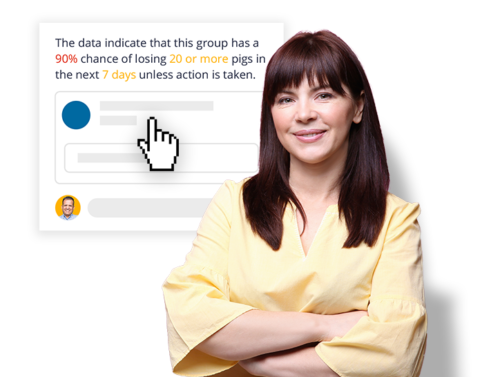Introduction
As unprecedented numbers of the population are dealing with enforced self-isolation in the midst of the global COVID-19 pandemic, never has it been more important to look to new technologies and innovative practices to help pork production remain viable and profitable.
At times like these, it’s natural for everyone involved in pork production to have concerns about how they can continue to identify and respond to pig health issues with the utmost professionalism while working remotely.
And just as importantly, how the sector can thrive in the face of ongoing disease-related challenges.
At times like these, it’s natural for everyone involved in pork production to have concerns about how they can continue to identify and respond to pig health issues
Telemedicine and telehealth are essential tools to help Veterinarians and Pork Producers achieve this, through remote collaboration.
While this might have felt like a low priority until recently, outbreaks such as COVID-19 and African swine fever are a sharp wake-up call on how critical it is to minimize exposure and spread of contagious diseases – both for the pigs, and the people involved in every stage of production.
As a consequence, the FDA is allowing veterinarians to “expand the use of telemedicine in the care of animals.” [2]

Request a FREE Demo of EveryPig’s telemedicine platform to reduce health risks today
Get Your Free DemoWhat is Telemedicine?
Telemedicine and telehealth are not new concepts in human health. Although adoption has historically been slow, the practice has been in place for many decades.
The original definition of telemedicine was “healing from a distance”. However, as technology increasingly became an important aspect of telemedicine in the 1960s and beyond, the World Health Organization settled on a broader definition, as follows:
It’s an important time to also bring telemedicine into the spotlight for animal health and the food production sector
“The delivery of healthcare services, where distance is a critical factor, by all healthcare professionals using information and communication technologies for the exchange of valid information for diagnosis, treatment and prevention of disease and injuries, research and evaluation, and for the continuing education of healthcare providers, all in the interests of advancing the health of individuals and their communities.” [1]
The more generic term telehealth signifies services provided by health professionals in general, although the terms tend to be used interchangeably.
Telemedicine’s Transition Into Farming and Veterinary Services
Now that COVID-19 has spread around the world, we’ve become accustomed to seeing medical staff make more use of telemedicine for human disease control.
This is why it’s an important time to also bring telemedicine into the spotlight for animal health and the food production sector.
The expanded use of telemedicine is now backed by the FDA, as evidenced in their press release on March 24th 2020, saying it intends to temporarily not enforce certain requirements in order to allow veterinarians to better utilize telemedicine to address animal health needs during the pandemic.
“The FDA recognizes the vital role veterinarians play in protecting public health. This pandemic has had impacts on many of our everyday lives and professions, and during this time, we need to provide veterinarians with the latitude to expand the use of telemedicine in the care of animals, not only pets but also the animals that produce our food,” said FDA Commissioner Stephen M. Hahn, M.D. “The FDA is providing flexibility that will help veterinarians maintain the health of animals during the pandemic, while allowing for the social distancing that is so important in limiting the further spread of coronavirus disease across the country and the world.” [2]

Request a FREE Demo of EveryPig’s Telemedicine platform to learn more about how your teams can work remotely, while also improving efficiency
Free DemoLikewise, the American Association of Swine Veterinarians makes the following COVOD-19 recommendation, among others, for veterinarians and their clients:
“Avoid close contact and practice social distancing when possible. If you or your staff are able, work remotely. Maintain at least 6 feet between contacts.” [3]
Telemedicine is a proven method to reduce the spread of contagious diseases
While there are a number of ways to attempt to adhere to this guidance, telemedicine is a proven method to reduce the spread of contagious diseases, while still ensuring the highest professional standards can still be maintained during these challenging times.
How EveryPig’s Telehealth Platform Can Help You Reduce the Spread of Contagious Diseases, While Also Improving Production Efficiency
EveryPig is a revolutionary pig health management platform that specializes in enabling veterinarians and pork production teams to identify and respond to pig health issues remotely, in real-time.
Created specifically for the pork production industry, their domain knowledge provides an easy-to-use, cutting-edge solution to ongoing disease challenges in the sector.
Although the current guidance issued by the FDA is temporary, the potential for telemedicine to be an important part of the VCPR will continue to exist.
Furthermore, although the current guidance issued by the FDA is temporary, the potential for telemedicine to be an important part of the VCPR will continue to exist.
The benefits of using EveryPig’s online telehealth platform for remote, collaborative care, instead of in-person visits include:
- Giving pig owners real-time access to veterinarian care so they can get on top of disease issues fast, without needing to wait for a barn visit
- Enabling veterinarians to efficiently provide top-quality healthcare and advice to dozens of farms daily, without needing to travel to farms in-person
- Increasing farm biosecurity by reducing in-person disease transmission between sites, and enabling faster identification and treatment of disease
- Improved vet coverage, resulting in lower mortality and higher profits
EveryPig is the only telemedicine solution of its kind, created specifically to meet the needs of pig owners, producers, and veterinarians.
This easy-to-use app is a unique software solution that enables you to collect secure data, collaborate with your team, provide veterinary services in real-time, and track outcomes, while remaining 100% compliant with WHO advice on maintaining social distancing.
It can be accessed on almost any modern device with a browser and access to the internet, including smartphones, tablets, and desktop computers, making it simple to use for caregivers, producers, and veterinarians.
Plus, the EveryPig app includes unique, industry-first, artificial intelligence capabilities to provide treatment recommendations, accurately forecast mortalities, and recognize illnesses in post-mortem images, saving veterinarians time, and improving pig health outcomes.
EveryPig is being rapidly adopted within the pork production industry and is now being used by more than 1,550 pork producers and veterinarians in the United States, Canada, and Brazil.
With a commitment to global capability, the app is currently available in seven languages including English, Portuguese, Spanish, Simplified Chinese, Korean, Vietnamese and French.
If you would like to reduce disease transmission through remote-working, and improve efficiency and pig health outcomes, request a complimentary demo of the EveryPig platform today:
[1] https://www.who.int/goe/publications/goe_telemedicine_2010.pdf
